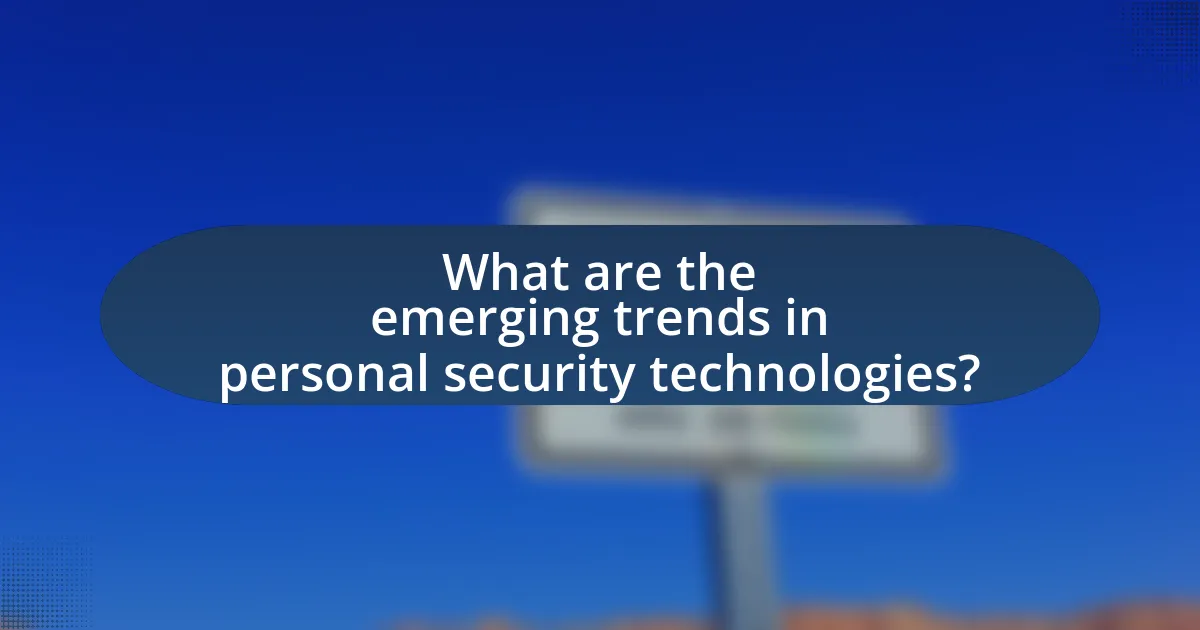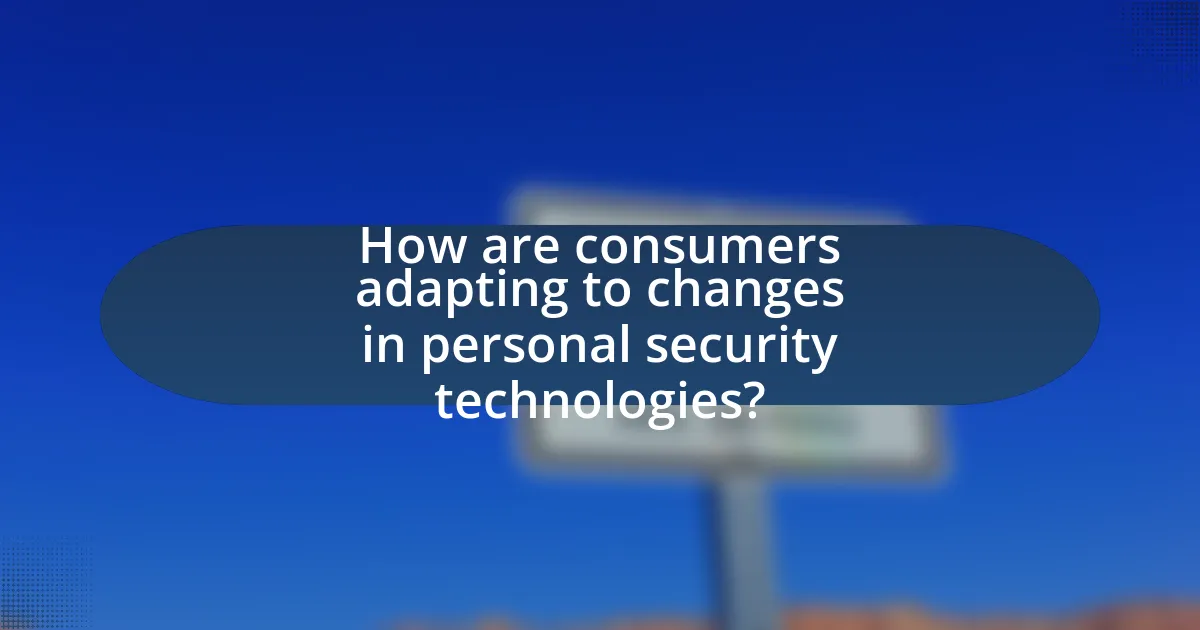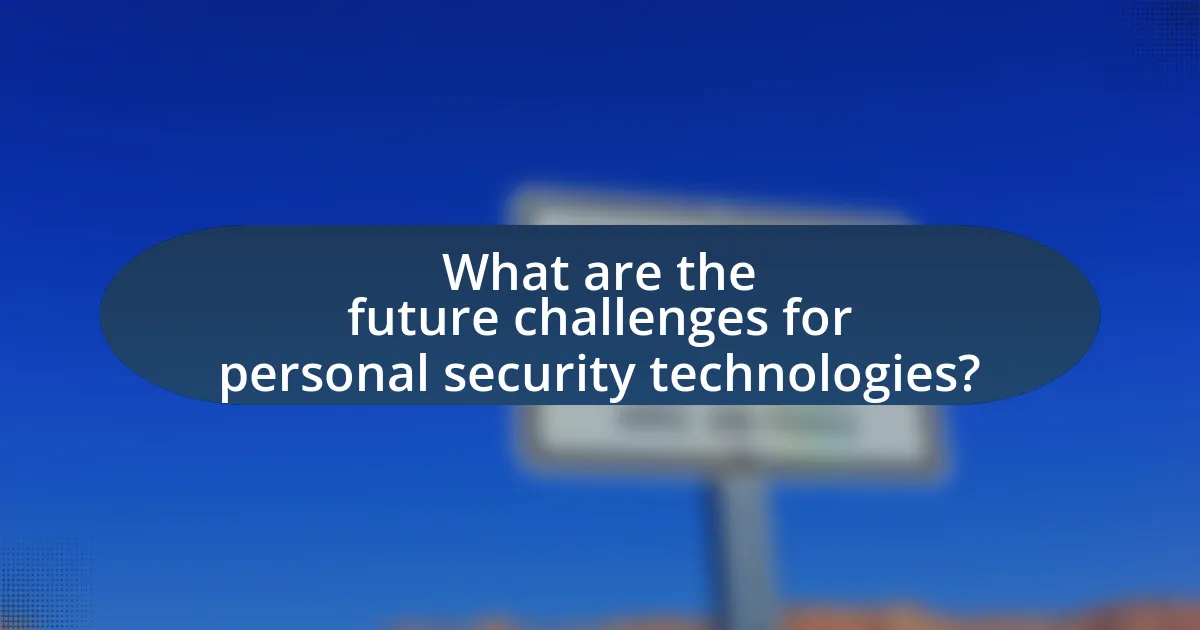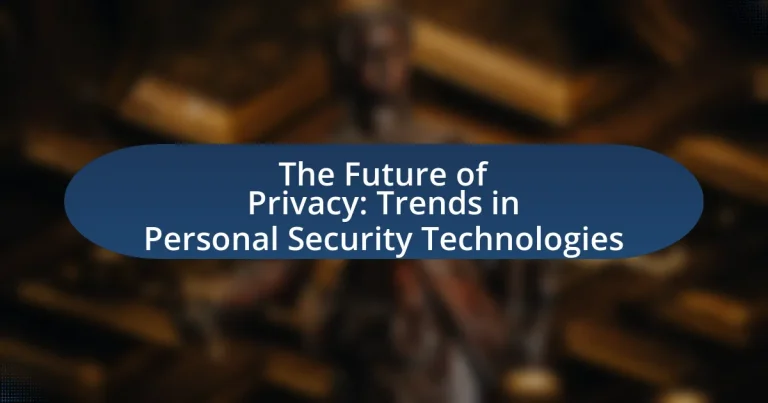The article “The Future of Privacy: Trends in Personal Security Technologies” examines the evolving landscape of personal security technologies, highlighting key trends such as the integration of artificial intelligence, biometric authentication, and smart home security systems. It discusses how advancements in technology are reshaping personal privacy, emphasizing the implications of increased surveillance and the role of government regulations. The article also explores consumer behavior regarding technology adoption, the impact of privacy concerns, and the unique security needs of different demographics. Additionally, it addresses future challenges for personal security technologies, including the sophistication of cyber threats and the importance of user education in enhancing security measures.

What are the emerging trends in personal security technologies?
Emerging trends in personal security technologies include the integration of artificial intelligence, biometric authentication, and smart home security systems. Artificial intelligence enhances threat detection and response capabilities, allowing for real-time monitoring and analysis of security incidents. Biometric authentication, such as facial recognition and fingerprint scanning, provides more secure access control compared to traditional passwords. Smart home security systems, which often incorporate IoT devices, enable users to monitor their homes remotely and receive alerts about potential security breaches. These trends reflect a growing emphasis on proactive security measures and user convenience in personal safety.
How are advancements in technology shaping personal privacy?
Advancements in technology are significantly shaping personal privacy by increasing data collection capabilities and enhancing surveillance methods. For instance, the proliferation of smartphones and IoT devices has led to the continuous gathering of personal data, often without explicit consent. According to a 2021 report by the Pew Research Center, 81% of Americans feel that the potential risks of companies collecting their data outweigh the benefits. Furthermore, technologies such as facial recognition and artificial intelligence enable more intrusive monitoring, raising concerns about individual privacy rights. A study published in the journal “Nature” in 2020 highlighted that AI-driven surveillance systems can identify individuals with over 90% accuracy, illustrating the extent to which technology can compromise personal privacy.
What role do artificial intelligence and machine learning play in personal security?
Artificial intelligence and machine learning significantly enhance personal security by enabling advanced threat detection and response systems. These technologies analyze vast amounts of data in real-time to identify patterns indicative of security breaches or suspicious activities. For instance, AI-driven surveillance systems can recognize faces and behaviors, allowing for immediate alerts when unauthorized individuals are detected. According to a report by McKinsey & Company, organizations that implement AI in security can reduce incident response times by up to 90%. Additionally, machine learning algorithms continuously improve their accuracy by learning from new data, making them increasingly effective at predicting and preventing security threats.
How is biometric authentication evolving in personal security technologies?
Biometric authentication is evolving in personal security technologies through advancements in accuracy, speed, and integration with artificial intelligence. Modern systems utilize multi-modal biometrics, combining fingerprints, facial recognition, and voice patterns to enhance security and reduce false positives. For instance, the global biometric market is projected to reach $59.31 billion by 2025, reflecting a growing reliance on these technologies for secure access in various sectors, including finance and healthcare. Additionally, innovations such as liveness detection and anti-spoofing measures are being implemented to prevent fraud, ensuring that biometric systems are more resilient against attacks.
What are the implications of increased surveillance on personal privacy?
Increased surveillance significantly undermines personal privacy by enabling the collection and analysis of vast amounts of personal data without consent. This pervasive monitoring can lead to a chilling effect on free expression, as individuals may alter their behavior due to the awareness of being watched. Research from the Pew Research Center indicates that 81% of Americans feel that the potential risks of companies collecting personal data outweigh the benefits. Furthermore, increased surveillance raises concerns about data security, as breaches can expose sensitive information, leading to identity theft and other privacy violations. The implications extend to societal trust, as citizens may become wary of government and corporate entities, fearing misuse of their data.
How do government regulations impact personal security technologies?
Government regulations significantly shape the development and deployment of personal security technologies by establishing standards for privacy, data protection, and compliance. These regulations, such as the General Data Protection Regulation (GDPR) in Europe, mandate that companies implement robust data security measures and obtain user consent for data collection, which directly influences how personal security technologies are designed and operated. For instance, compliance with GDPR has led to the adoption of encryption and anonymization techniques in personal security devices to protect user data, demonstrating that regulatory frameworks can drive technological innovation while ensuring user privacy.
What ethical considerations arise from the use of surveillance technologies?
The ethical considerations arising from the use of surveillance technologies include privacy invasion, consent, and potential misuse of data. Surveillance technologies often collect personal information without individuals’ explicit consent, leading to significant privacy concerns. For instance, a study by the Electronic Frontier Foundation highlights that 79% of Americans express concern about government surveillance, indicating a widespread apprehension regarding privacy violations. Additionally, the potential for data misuse by both governmental and private entities raises ethical questions about accountability and transparency. The lack of clear regulations governing the use of surveillance technologies further complicates these ethical dilemmas, as evidenced by various legal challenges surrounding data protection laws globally.

How are consumers adapting to changes in personal security technologies?
Consumers are adapting to changes in personal security technologies by increasingly integrating smart devices into their daily lives. This shift is evidenced by the growing adoption of home security systems, such as smart cameras and alarms, which allow users to monitor their properties remotely via mobile applications. According to a report by Statista, the global smart home security market is projected to reach approximately $74 billion by 2023, indicating a significant consumer trend towards enhanced security measures. Additionally, consumers are becoming more aware of data privacy issues, leading them to choose products that offer robust encryption and user control over personal information. This adaptation reflects a proactive approach to personal safety and privacy in response to evolving technological landscapes.
What factors influence consumer trust in personal security solutions?
Consumer trust in personal security solutions is influenced by several key factors, including transparency, reliability, user experience, and brand reputation. Transparency regarding data handling practices fosters trust, as consumers are more likely to trust solutions that clearly communicate how their information is used and protected. Reliability is crucial; solutions that consistently perform as promised build confidence among users. A positive user experience, characterized by ease of use and effective functionality, also enhances trust, as consumers prefer solutions that are intuitive and meet their needs effectively. Additionally, a strong brand reputation, often established through positive reviews and endorsements, significantly impacts consumer trust, as individuals tend to rely on the experiences of others when making decisions about security solutions.
How do privacy concerns affect consumer behavior regarding technology adoption?
Privacy concerns significantly influence consumer behavior regarding technology adoption by creating hesitance and skepticism towards new technologies. When consumers perceive a risk to their personal data, they are less likely to adopt technologies that require data sharing or surveillance. For instance, a 2021 survey by Pew Research Center found that 81% of Americans feel that the potential risks of companies collecting their personal data outweigh the benefits. This apprehension leads consumers to favor products that prioritize privacy features, such as end-to-end encryption and minimal data collection practices. Consequently, companies that address these privacy concerns through transparent policies and robust security measures are more likely to gain consumer trust and drive technology adoption.
What are the most popular personal security technologies among consumers?
The most popular personal security technologies among consumers include smart home security systems, mobile security applications, and biometric authentication methods. Smart home security systems, such as Ring and Arlo, have gained traction due to their ability to provide real-time surveillance and remote monitoring, with the global smart home security market projected to reach $78.9 billion by 2024. Mobile security applications, like Norton and McAfee, are widely used for protecting personal devices from malware and cyber threats, reflecting a growing concern for digital safety. Biometric authentication methods, including fingerprint and facial recognition, are increasingly adopted for their convenience and enhanced security, with a report indicating that the biometric market is expected to grow to $56.8 billion by 2025.
How do personal security technologies vary across different demographics?
Personal security technologies vary significantly across different demographics due to factors such as age, income, and geographic location. For instance, younger individuals tend to adopt mobile security applications and smart home devices more readily, reflecting their comfort with technology and digital platforms. In contrast, older adults may prefer traditional security measures, such as alarm systems and personal safety devices, due to less familiarity with advanced technologies.
Income levels also influence the adoption of personal security technologies; higher-income individuals are more likely to invest in sophisticated security systems, including surveillance cameras and smart locks, while lower-income demographics may rely on basic security measures due to budget constraints. Geographic location plays a role as well; urban residents often utilize more advanced technologies due to higher crime rates, while those in rural areas may prioritize different security solutions based on their specific needs and risks.
These variations highlight how personal security technologies are tailored to meet the unique preferences and requirements of different demographic groups.
What are the unique security needs of different age groups?
Different age groups have unique security needs that reflect their varying levels of vulnerability and technological familiarity. For children, security needs often focus on online safety, including parental controls and monitoring tools to protect against cyberbullying and inappropriate content. Adolescents require privacy measures that balance independence with safety, such as social media privacy settings and education on digital footprints. Adults typically prioritize identity theft protection and secure online transactions, necessitating robust password management and awareness of phishing scams. Seniors often face challenges related to scams and fraud, leading to a need for user-friendly technology that includes simplified security features and education on recognizing fraudulent activities. Research indicates that tailored security solutions can significantly enhance the safety and privacy of individuals across these age groups, as highlighted in studies by the Pew Research Center, which found that younger users are more likely to experience online harassment, while older adults are more susceptible to financial scams.
How do cultural differences influence the adoption of personal security technologies?
Cultural differences significantly influence the adoption of personal security technologies by shaping individuals’ perceptions of privacy, trust, and technology use. For instance, in collectivist cultures, where community and social harmony are prioritized, there may be greater skepticism towards personal security technologies that are perceived to infringe on communal privacy. Conversely, in individualistic cultures, where personal autonomy is valued, individuals may be more inclined to adopt such technologies for personal safety and convenience. Research by the Pew Research Center indicates that attitudes towards surveillance and data privacy vary widely across cultures, with some populations more accepting of monitoring for security purposes than others. This cultural context directly impacts the willingness to embrace personal security technologies, as seen in varying adoption rates across different regions and demographics.

What are the future challenges for personal security technologies?
Future challenges for personal security technologies include the increasing sophistication of cyber threats, which demand continuous advancements in security measures. As technology evolves, hackers are employing more complex methods, such as artificial intelligence and machine learning, to breach systems. Additionally, the proliferation of Internet of Things (IoT) devices creates more entry points for attacks, complicating security protocols. Privacy concerns also pose a significant challenge, as users demand greater control over their data while navigating regulations like GDPR. Furthermore, the balance between convenience and security remains a critical issue, as users often prioritize ease of use over robust security features. These challenges necessitate ongoing innovation and adaptation in personal security technologies to effectively protect users.
How will evolving cyber threats impact personal security technologies?
Evolving cyber threats will significantly enhance the development and sophistication of personal security technologies. As cybercriminals increasingly employ advanced tactics such as artificial intelligence and machine learning to exploit vulnerabilities, personal security technologies must adapt by integrating more robust encryption methods, real-time threat detection, and multi-factor authentication systems. For instance, the rise in ransomware attacks, which increased by 150% in 2020 according to Cybersecurity Ventures, has prompted security technology developers to focus on creating solutions that can proactively identify and mitigate such threats before they cause harm. This ongoing arms race between cyber threats and security technologies will lead to continuous innovation and improvement in personal security measures.
What strategies can be implemented to mitigate these cyber threats?
To mitigate cyber threats, organizations should implement a multi-layered security approach that includes regular software updates, employee training, and robust access controls. Regular software updates ensure that vulnerabilities are patched, reducing the risk of exploitation; for instance, the 2020 Microsoft Exchange Server vulnerabilities highlighted the importance of timely updates, as they were exploited by attackers shortly after discovery. Employee training on recognizing phishing attempts and safe online practices can significantly reduce the likelihood of successful attacks, as studies show that human error is a leading cause of data breaches. Additionally, robust access controls, such as multi-factor authentication, can prevent unauthorized access to sensitive systems, as evidenced by the fact that organizations using multi-factor authentication can reduce account compromise by 99.9%.
How can personal security technologies adapt to changing user needs?
Personal security technologies can adapt to changing user needs by incorporating user feedback, leveraging artificial intelligence, and enhancing interoperability. User feedback allows developers to understand specific concerns and preferences, leading to tailored solutions. For instance, a survey by the Pew Research Center found that 81% of Americans feel that the potential risks of companies collecting their personal data outweigh the benefits, indicating a demand for more transparent and user-controlled security options. Artificial intelligence can analyze user behavior and predict security threats, enabling proactive measures. Additionally, enhancing interoperability among devices ensures that users can seamlessly integrate various security technologies, improving overall effectiveness. This adaptability is crucial as user expectations evolve in response to emerging threats and privacy concerns.
What role does user education play in enhancing personal security?
User education plays a critical role in enhancing personal security by equipping individuals with the knowledge and skills necessary to recognize and mitigate security threats. Educated users are more likely to adopt safe online behaviors, such as using strong passwords and being cautious of phishing attempts. Research indicates that organizations with comprehensive security training programs experience a 70% reduction in security incidents, demonstrating the effectiveness of user education in preventing breaches. By fostering awareness and promoting best practices, user education significantly contributes to a more secure digital environment.
How can individuals protect their privacy in an increasingly digital world?
Individuals can protect their privacy in an increasingly digital world by utilizing strong passwords, enabling two-factor authentication, and being cautious about the information they share online. Strong passwords, which are at least 12 characters long and include a mix of letters, numbers, and symbols, significantly reduce the risk of unauthorized access. Two-factor authentication adds an additional layer of security by requiring a second form of verification, such as a text message code, making it harder for attackers to gain access even if they have the password. Furthermore, individuals should regularly review privacy settings on social media platforms and limit the amount of personal information shared publicly, as studies show that oversharing can lead to identity theft and privacy breaches. According to a 2021 report by the Identity Theft Resource Center, nearly 1.4 million data breaches were reported, highlighting the importance of proactive privacy measures.
What best practices should users follow to ensure their personal security?
Users should follow several best practices to ensure their personal security, including using strong, unique passwords for each account, enabling two-factor authentication, and regularly updating software. Strong passwords, defined as those containing a mix of letters, numbers, and symbols, significantly reduce the risk of unauthorized access; studies show that 81% of data breaches are linked to weak passwords. Two-factor authentication adds an extra layer of security by requiring a second form of verification, which can prevent 99.9% of automated attacks. Regular software updates patch vulnerabilities that could be exploited by cybercriminals, as outdated software is a common entry point for attacks. By implementing these practices, users can significantly enhance their personal security.





